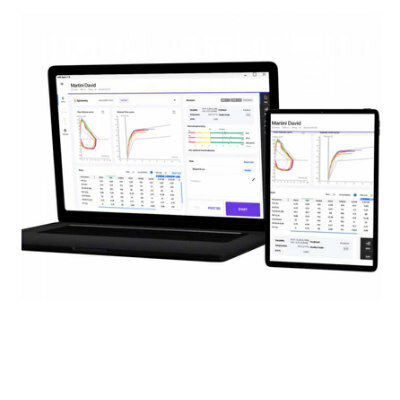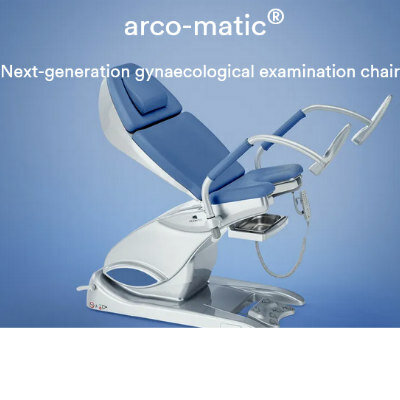Alphabet to Create Google Maps for Healthcare
|
By HospiMedica International staff writers Posted on 09 May 2017 |

Image: The Study Watch will help identify the origins of disease (Photo courtesy of Verily).
Verily, formerly known as Google Life Sciences, is launching Project Baseline, a four-year longitudinal health study designed to understand how people transition from being healthy to becoming sick, and to identify additional risk factors for diseases.
Together with Duke University and Stanford University, Verily will enroll 10,000 volunteers from diverse backgrounds at half a dozen study sites in California and North Carolina. Study participants will wear the Verily-developed Study Watch health tracker and will also have their genomes sequenced. Molecular indicators, such as microbiome and proteomics, will also be studied. The Baseline researchers are hoping that the sleep, activity, heart rate, genomics and other data will help identify find early warning signs for disease.
The Study Watch, which will be worn by participants on a daily basis, includes multiple physiological and environmental sensors designed to measure health data, including electrocardiogram (ECG), heart rate, electrodermal activity, and inertial movements. The watch has a long battery life of up to one week in order to improve user compliance. And large internal storage capacity and data compression will allow it to store weeks’ worth of raw data, thus relaxing the need for frequent synchronization. The firmware is also designed to be robust for future extensions, such as over-the-air updates, new algorithms, and user interface upgrades.
Because the investigational device stores health data, all data are encrypted, uploaded, and processed in the cloud using backend algorithms and machine learning tools. The infrastructure is highly scalable and can serve future population studies consisting of large volumes of data. The low power, high-resolution display is always on for an appealing look and a robust user interface. Currently, only time and certain instructions are displayed, with no other information provided back to the user.
“The Project Baseline study has the opportunity to significantly influence our current body of knowledge by better understanding the indicators of wellness,” said Nancy Brown, CEO of the American Heart Association (AHA). “The outcome of this study could inspire a new generation of tools that are geared towards disease prevention, versus just diagnosis and treatment.”
The Baseline Project is modeling itself on prior efforts, like the Framingham Heart Study, which kicked off in the late 1940s with more than 5,000 participants. The results of that study showed the importance of regular exercise and a healthy diet in maintaining good health, as well as the deleterious effects of smoking.
Together with Duke University and Stanford University, Verily will enroll 10,000 volunteers from diverse backgrounds at half a dozen study sites in California and North Carolina. Study participants will wear the Verily-developed Study Watch health tracker and will also have their genomes sequenced. Molecular indicators, such as microbiome and proteomics, will also be studied. The Baseline researchers are hoping that the sleep, activity, heart rate, genomics and other data will help identify find early warning signs for disease.
The Study Watch, which will be worn by participants on a daily basis, includes multiple physiological and environmental sensors designed to measure health data, including electrocardiogram (ECG), heart rate, electrodermal activity, and inertial movements. The watch has a long battery life of up to one week in order to improve user compliance. And large internal storage capacity and data compression will allow it to store weeks’ worth of raw data, thus relaxing the need for frequent synchronization. The firmware is also designed to be robust for future extensions, such as over-the-air updates, new algorithms, and user interface upgrades.
Because the investigational device stores health data, all data are encrypted, uploaded, and processed in the cloud using backend algorithms and machine learning tools. The infrastructure is highly scalable and can serve future population studies consisting of large volumes of data. The low power, high-resolution display is always on for an appealing look and a robust user interface. Currently, only time and certain instructions are displayed, with no other information provided back to the user.
“The Project Baseline study has the opportunity to significantly influence our current body of knowledge by better understanding the indicators of wellness,” said Nancy Brown, CEO of the American Heart Association (AHA). “The outcome of this study could inspire a new generation of tools that are geared towards disease prevention, versus just diagnosis and treatment.”
The Baseline Project is modeling itself on prior efforts, like the Framingham Heart Study, which kicked off in the late 1940s with more than 5,000 participants. The results of that study showed the importance of regular exercise and a healthy diet in maintaining good health, as well as the deleterious effects of smoking.
Latest Health IT News
- Machine Learning Model Improves Mortality Risk Prediction for Cardiac Surgery Patients
- Strategic Collaboration to Develop and Integrate Generative AI into Healthcare
- AI-Enabled Operating Rooms Solution Helps Hospitals Maximize Utilization and Unlock Capacity
- AI Predicts Pancreatic Cancer Three Years before Diagnosis from Patients’ Medical Records
- First Fully Autonomous Generative AI Personalized Medical Authorizations System Reduces Care Delay
- Electronic Health Records May Be Key to Improving Patient Care, Study Finds
- AI Trained for Specific Vocal Biomarkers Could Accurately Predict Coronary Artery Disease
- First-Ever AI Test for Early Diagnosis of Alzheimer’s to Be Expanded to Diagnosis of Parkinson’s Disease
- New Self-Learning AI-Based Algorithm Reads Electrocardiograms to Spot Unseen Signs of Heart Failure
- Autonomous Robot Performs COVID-19 Nasal Swab Tests

- Statistical Tool Predicts COVID-19 Peaks Worldwide
- Wireless-Controlled Soft Neural Implant Stimulates Brain Cells
- Tiny Polymer Stent Could Treat Pediatric Urethral Strictures
- Human Torso Simulator Helps Design Brace Innovations
- 3D Bioprinting Rebuilds the Human Heart
- Nanodrone Detects Toxic Gases in Hazardous Environments
Channels
Artificial Intelligence
view channel
AI-Powered Algorithm to Revolutionize Detection of Atrial Fibrillation
Atrial fibrillation (AFib), a condition characterized by an irregular and often rapid heart rate, is linked to increased risks of stroke and heart failure. This is because the irregular heartbeat in AFib... Read more
AI Diagnostic Tool Accurately Detects Valvular Disorders Often Missed by Doctors
Doctors generally use stethoscopes to listen for the characteristic lub-dub sounds made by heart valves opening and closing. They also listen for less prominent sounds that indicate problems with these valves.... Read moreCritical Care
view channel
Deep-Learning Model Predicts Arrhythmia 30 Minutes before Onset
Atrial fibrillation, the most common type of cardiac arrhythmia worldwide, affected approximately 59 million people in 2019. Characterized by an irregular and often rapid heart rate, atrial fibrillation... Read more
Breakthrough Technology Combines Detection and Treatment of Nerve-Related Disorders in Single Procedure
The peripheral nervous system (PNS) serves as the communication network that links the brain and spinal cord to every other part of the body. It consists of two parts: the somatic nervous system, which... Read moreSurgical Techniques
view channel
Hydrogel-Based Miniaturized Electric Generators to Power Biomedical Devices
The development of engineered devices that can harvest and convert the mechanical motion of the human body into electricity is essential for powering bioelectronic devices. This mechanoelectrical energy... Read moreWearable Technology Monitors and Analyzes Surgeons' Posture during Long Surgical Procedures
The physical strain associated with the static postures maintained by neurosurgeons during long operations can lead to fatigue and musculoskeletal problems. An objective assessment of surgical ergonomics... Read more.jpg)
Custom 3D-Printed Orthopedic Implants Transform Joint Replacement Surgery
The evolving field of 3D printing is revolutionizing orthopedics, especially for individuals requiring joint replacement surgeries where traditional implants fail to provide a solution. Although most people... Read more
Cutting-Edge Imaging Platform Detects Residual Breast Cancer Missed During Lumpectomy Surgery
Breast cancer is becoming increasingly common, with statistics indicating that 1 in 8 women will develop the disease in their lifetime. Lumpectomy remains the predominant surgical intervention for treating... Read morePatient Care
view channel
Surgical Capacity Optimization Solution Helps Hospitals Boost OR Utilization
An innovative solution has the capability to transform surgical capacity utilization by targeting the root cause of surgical block time inefficiencies. Fujitsu Limited’s (Tokyo, Japan) Surgical Capacity... Read more
Game-Changing Innovation in Surgical Instrument Sterilization Significantly Improves OR Throughput
A groundbreaking innovation enables hospitals to significantly improve instrument processing time and throughput in operating rooms (ORs) and sterile processing departments. Turbett Surgical, Inc.... Read more
Next Gen ICU Bed to Help Address Complex Critical Care Needs
As the critical care environment becomes increasingly demanding and complex due to evolving hospital needs, there is a pressing requirement for innovations that can facilitate patient recovery.... Read moreGroundbreaking AI-Powered UV-C Disinfection Technology Redefines Infection Control Landscape
Healthcare-associated infection (HCAI) is a widespread complication in healthcare management, posing a significant health risk due to its potential to increase patient morbidity and mortality, prolong... Read morePoint of Care
view channel
Critical Bleeding Management System to Help Hospitals Further Standardize Viscoelastic Testing
Surgical procedures are often accompanied by significant blood loss and the subsequent high likelihood of the need for allogeneic blood transfusions. These transfusions, while critical, are linked to various... Read more
Point of Care HIV Test Enables Early Infection Diagnosis for Infants
Early diagnosis and initiation of treatment are crucial for the survival of infants infected with HIV (human immunodeficiency virus). Without treatment, approximately 50% of infants who acquire HIV during... Read more
Whole Blood Rapid Test Aids Assessment of Concussion at Patient's Bedside
In the United States annually, approximately five million individuals seek emergency department care for traumatic brain injuries (TBIs), yet over half of those suspecting a concussion may never get it checked.... Read more
New Generation Glucose Hospital Meter System Ensures Accurate, Interference-Free and Safe Use
A new generation glucose hospital meter system now comes with several features that make hospital glucose testing easier and more secure while continuing to offer accuracy, freedom from interference, and... Read moreBusiness
view channel
Johnson & Johnson Acquires Cardiovascular Medical Device Company Shockwave Medical
Johnson & Johnson (New Brunswick, N.J., USA) and Shockwave Medical (Santa Clara, CA, USA) have entered into a definitive agreement under which Johnson & Johnson will acquire all of Shockwave’s... Read more
















